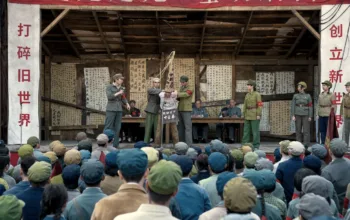Candyman in 2021 may feel made for the Black Lives Matter era — but its themes were present from the start.
When Nia DaCosta’s reimagined Candyman, co-written and produced by Jordan Peele, arrives in theaters this weekend, it will inevitably bring with it a host of questions for audiences about how much of it is based in reality.
Chicago’s Cabrini-Green housing project, where our heroes encounter the titular killer at the center of the story, is a real place with a long and controversial history. The Candyman himself is pure fiction — he’s the ghost of Daniel Robitaille, a wrongfully accused slave who was lynched, mutilated, and given a terrifying hook for a hand before his murder. Now, hellbent on vengeance, he appears if you summon him by saying his name five times in front of a mirror, Bloody Mary-style.
As a horror figure, Candyman feels like a real-life urban legend that’s always been with us. It’s easy to believe that Daniel Robitaille himself could be a real historical figure because his story is similar to the stories so many victims of racist violence in America. In actuality, the Candyman himself comes to us courtesy of legendary British horror writer Clive Barker, who made up the story in a 1985 novella before another British guy, Bernard Rose, adapted, wrote, and directed the 1992 film that made the Candyman a household name in the horror genre.
However, there are still elements of truth to the story as it’s been embellished on film over the years. The original Candyman turned Barker’s lore into an exploration of generational trauma and racial injustice. Crucially, the 1992 film fictionalized a horrific real-life murder that took place in a Chicago public housing project not far from Cabrini-Green — an incident that drew attention to the inequality of life in the city’s segregated high-rise districts. By drawing on that event, the movie became a startling treatise on modern Black identity and the cost of modern urbanization.
DaCosta’s update hones in on Candyman as a direct byproduct of the violence visited upon Black communities in the US. The new film, like the 1992 original, also looks at the tale through the lens of urbanization and the perpetual harm done to urban Black communities as they were first forced into segregated housing, totally neglected, and later ejected from their homes due to gentrification.
These deep themes are not new to the Candyman narrative; the new, socially conscious Candyman is really just an expansion of all the material that made the original film so haunting.
The Candyman films borrow from a terrifying real-life tragedy to tell a story about Black community and survival
/cdn.vox-cdn.com/uploads/chorus_asset/file/22806504/1074406488.jpg) Daniel Acker / Getty Images
Daniel Acker / Getty ImagesThe basic plot of the new Candyman is spiritually similar to that of the original: A curious innocent encounters the Candyman myth and becomes a foil for the grisly murders he commits with his horrible hook, as his legend spreads and more people summon him. In the original 1992 film, white Chicago grad student Helen Lyle (Virginia Madsen) embarks on what is essentially slum tourism as she trawls the Cabrini-Green housing project for proof of the urban legend. In the new film, Black artist Anthony McCoy (Yahya Abdul-Mateen II) moves into a now gentrified, luxury edition of Cabrini and finds himself drawn to the story of Candyman — unaware that he has a direct personal connection to Candyman’s 1992 killing spree.
In both the original film and DaCosta’s reimagining, the Candyman himself exists in part because he reflects the racial injustice suffered by centuries of Black Americans. In the new film, that link is even more overt: The Candyman of 2021 is still a ruthless serial killer, but he also makes himself available as a tool for Black vengeance, so that the violence he enacts becomes a kind of catharsis for Black pain.
This aspect of the new film is all the more fascinating, not only because the original Candyman was groundbreaking in its choice to center its horror narrative within an urban Black community but also because the Candyman story was not originally intended to be a metaphor for Black survival. Barker’s original novella, The Forbidden, first published in his self-published zine Fantasy Tales in 1985, contributed the basic plot that became Rose’s 1992 film, but none of the backstory or underlying subtext. Instead of a racially segregated US housing project, Barker’s story is set in a poverty-stricken section of Liverpool. There, a young research student, Helen Lyle, encounters graffiti warning of the Candyman, digs into the lore surrounding him, and discovers a sophisticated, effete serial killer.
Barker’s rendering of Candyman was a pale, oddly dressed blond man. After Rose cast Tony Todd in the title role of the 1992 film, Todd — whose performance would make him an instant horror icon — created his own new backstory for the character. Thus Candyman became the doomed slave Daniel Robitaille.
Even before casting Todd, Rose had decided to transfer the setting to Chicago’s inner-city housing projects. That change defined what Candyman would become. “Candyman is very much part of the urban landscape,” Todd said in a 2011 interview. “I can’t go to any hood in this country without total recognition from the people who live there.”
The complex that Rose selected, Cabrini-Green, was part of a long-planned set of public housing developments built in the midcentury. Originally, Chicago’s public housing projects had been envisioned as progressive communities spread throughout the city, but that idea immediately fell victim to racism: The city council flatly refused to allow public housing projects in white neighborhoods, forcing them to be wedged into inner-city Black neighborhoods instead.
Despite the happy image of Cabrini-Green put forth by the hit sitcom Good Times (1974–79), which was also set there, the community’s walled-off, difficult-to-access high-rise design facilitated a rise in crime. The Chicago Housing Authority soon abandoned maintaining the neighborhood’s basic infrastructure. Structural racism led to numerous other obstacles like poverty and overcrowding, and the area became notorious for danger and disrepair.
In a 2015 interview, Rose recalled that the Illinois Film Commission originally suggested Cabrini-Green as a potential film location, taking him on a tour there because it was, well, scary. “I realized that this was an incredible arena for a horror movie because it was a place of such palpable fear,” he said. “[F]ear of the urban housing project, it seemed to me, was actually totally irrational because you couldn’t really be in that much danger. Yes, there was crime there, but people were actually afraid of driving past it. And there was such an aura of fear around the place and I thought that was really something interesting to look into because it’s sort of a kind of fear that’s at the heart of modern cities.”
Cabrini-Green was only one of numerous struggling Chicago housing projects making headlines at the time Rose was planning Candyman. In 1987, Chicago reporter Steve Bogira published an incredible feat of long-form journalism with the terrifying headline, “They Came in Through the Bathroom Mirror,” examining the still-unsolved murder of Ruthie Mae McCoy, a 52-year-old grandmother who lived in another housing project known as the ABLA.
On April 22, 1987, McCoy phoned 911 from her ABLA apartment to report that someone was breaking into her apartment through the medicine cabinet. The 911 dispatchers, apparently struggling to understand her story, reported it to police as a disturbance rather than a break-in. After more neighbors called 911 to report hearing gunshots, police turned up, knocked on McCoy’s door, and eventually left without entering. Her body was discovered two days later; she had been shot four times.
Minimal police investigation into McCoy’s death meant a dearth of evidence, so that when two suspects were apprehended and finally prosecuted three years later, both men were ultimately acquitted. Bogira, who covered the trial with the same depth as the murder, quoted a striking, pain-filled interview with McCoy’s surviving brother.
The more McCoy talked, though, the more his anger seeped out. “Judgment does not proceed the way that it should,” he said. “If that had been a white woman had been killed like that with two black guys charged, they would have been convicted. If that would have been a white woman that called police like my sister did, you know they would have gone in [her apartment]. You know it.
“This whole system we’re living in is corrupt,” he said. He tries not to dwell on the injustices in it. “If you do, you will explode! You will explode.”
This real-life pain and anger felt by Black communities provided an underpinning to Rose’s 1992 Candyman that persists in the new film, as Candyman becomes a metaphor for the repressed anger McCoy described to Bogira.
Ironically, though, the route that initially brought Ruthie McCoy’s death to the movies was less about racial justice and more about Hollywood artists profiting off an, erm, killer story premise.
The new film tries to deconstruct Candyman’s real-life backstory — not entirely effectively
/cdn.vox-cdn.com/uploads/chorus_asset/file/22806866/3.jpg)
Writing about his first viewing of Candyman in 2014, Bogira recalled how the actor John Malkovich approached him soon after his first article about McCoy’s murder; Malkovich was interested in making a movie based on her story. He specifically had the idea “that the lead character be a white reporter investigating a medicine-cabinet killing” — which sounds very similar to what Virginia Madsen’s portrayal of Helen Lyle eventually became. (Malkovich had no known involvement in the 1992 film.)
It’s unclear whether Rose himself was aware of Bogira’s news coverage — he doesn’t seem to have ever mentioned it in interviews. Still, the threads connecting Rose’s 1992 Candyman to McCoy’s case are visible: In the film, Ruthie Mae McCoy becomes “Ruthie Jean,” and Helen investigates Ruthie Jean’s murder by visiting her rundown apartment in Cabrini. When the fictional murder goes unsolved, the other residents attribute it to the work of Candyman, and it becomes the stuff of nightmare fuel. Then there’s the role of Anthony McCoy — a minor character in the 1992 film and the protagonist of the 2021 film — who is the namesake of the real-life Ruthie.
For Candyman, Rose combined the real-life “medicine cabinet” element of McCoy’s murder with the urban legend elements of a killer with a hooked hand and summoning a ghost by chanting into a mirror. Instead of a single unsolved murder, the film presents a string of supernatural slayings; instead of Bloody Mary peeping over our shoulder, we get Candyman and the specter of trauma he represents.
DaCosta’s 2021 interpretation of the story is more than a little uneasy about the relationship Rose forged between tragedy and art. It seems to be at pains to work through its own feelings about the arguably glib way in which the 1992 film’s white filmmaker approached the subject of life — and death — in the projects. The new film fixates both on Cabrini-Green’s past and its post-’90s transformation. After being vacated and razed in the mid-‘90s, the grounds where the real Cabrini-Green once stood have become a locus of controversy, thanks to ongoing attempts to build luxury housing there at the expense of urban renewal. A 2018 Census report revealed that the area had become the fastest-growing luxury development area in the US, home to the highest number of high-income earners.
The 2021 Candyman heavily emphasizes this irony by having several characters call out the perceived hypocrisy of Anthony living there. As one art critic points out to him, he’s living in an apartment built over the rubble of a failed housing project while trying to sell art based on its stories. He has exploited the place for his own benefit, she insists. (As the film critic Angelica Jade Bastién writes at Vulture, the film’s one-dimensional framing of Black gentrification as equivalent to the white supremacist system that created the projects to begin with is arguably one of the areas in which it fails as an effective critique of that system.)
Yet if Anthony seems to be a projection of Rose’s original exploitation of the projects, at least to some degree, then he has also been exploited himself, always by gleeful white capitalists. Anthony and his art curator girlfriend Brianna (Teyonah Parris) both experience the humiliation of being tokenized by various people in the industry. At one point, a white curator impatiently demands that Anthony be “the great Black hope” of the Chicago art world. In another scene, Brianna visibly cringes when an oblivious colleague brings up Brianna’s own family tragedy — her father died by suicide — as though it makes Brianna herself more marketable as an artist.
The film leans heavily on the connection between capitalism and the exploitation of Black art for white entertainment. Right before being brutally murdered, the art critic tells Anthony that a work she had previously excoriated is suddenly interesting now that it is connected to a set of murders. Anthony’s art, which depicts the lynching of a Black man, is only valuable to her once it becomes linked to something more interesting than “just” Black pain.
The film paints most of these characters as vultures of the art world, often using the high-flown linguistic semantics of academia and artistic discourse to obfuscate the vapid nature of the work they’re doing. It’s hardly any wonder that when Candyman comes, he comes for them first.
Meanwhile, the new Candyman takes care to remind us that the violence that gave birth to its titular killer is cyclical. The system of injustice that created and later destroyed Cabrini-Green still casts a shadow over its legacy; the racist brutality that Black Americans perpetually face still haunts the premises. The biggest key to this theme is Candyman himself. The new film’s tag line, “Say his name,” is a direct reference to the “Say her name” social media activism of the Black Lives Matter movement. And though the original Candyman is Daniel Robitaille, martyred slave, he’s not the only one: In the 2021 film, we’re introduced to Candyman not as Daniel Robitaille but as a composite of multiple martyred Black men. Again blending fiction and real life, the movie names real-life Chicago lynching victim William Bell as one of the iterations of Candyman over the decades — one of many Black men who’ve suffered the same brutal fate and tapped into the same well of collective vengeance.
The 2021 Candyman tries so hard to turn Tony Todd’s villain into a sympathetic form of Black retribution that its moral framework may ultimately be too flattened for some viewers; at my screening, a mostly silent audience burst into chuckles when the credits concluded and then entreated viewers to visit the movie’s social impact website, where Black creators and artists canvass its themes in detail.
Moreover, the movie’s over-the-top symbolism often dulls its own impact. For instance, characters are frequently visually hemmed in by the cramped layouts of the urban architecture they’re in, as if to emphasize how little agency Anthony and the other characters have over their fates. On the one hand, it’s an elegant DePalma-like technique; on the other, it’s the kind of thing that’s so blaring that the whole film sometimes feels like a 101 instruction manual for white viewers rather than delivering the true catharsis that the best horror often invokes. In the worst reading, Candyman itself becomes the exact sort of exploitation of Black trauma that it is attempting to deconstruct.
Nonetheless, if this blatant moralizing is a flaw, it’s also hard to blame Candyman 2021 for it. The elements of Candyman that are real are, after all, cyclical. Turning Candyman himself into a cyclical entity is one way of responding to real-world violence that has no apparent end. In that act, at least, there’s undeniable power.
Author: Aja Romano
Read More



